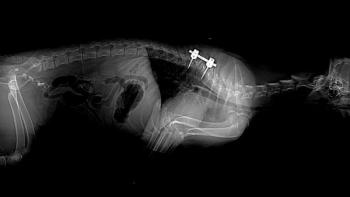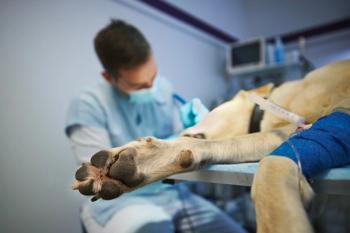
A pain in the neck: How to approach painful patients (Proceedings)
Spinal pain is a common cause of morbidity in domestic pets, but can be frustrating to manage, particularly if the signs are episodic and never present when you see the patient! The pet owners may be more emotional about a painful pet than about other medical problems, and somewhat defensive about describing the signs.
Spinal pain is a common cause of morbidity in domestic pets, but can be frustrating to manage, particularly if the signs are episodic and never present when you see the patient! The pet owners may be more emotional about a painful pet than about other medical problems, and somewhat defensive about describing the signs. It is therefore extremely important not to question whether pain is present or not, but simply to seek an accurate description of the signs. Spinal pain can be caused by disease of the meninges, the nerve roots, and the vertebral column, including the muscle and synovial joints. Animals with abdominal pain can present as if they have spinal pain. Careful evaluation of the patient is therefore necessary.
History and physical examination
When obtaining a history it is very important to ask the owner to describe what signs their pet shows when it is painful. Key phrases like "stiff neck, reluctant to move, cries out when touched, holds up a limb, limps, tries to bite, won't let other animals near them" are all indicators that the animal is indeed in pain rather than having a seizure for example. Descriptions of body posture and responsiveness are useful. It is also important to know when the animal shows signs of pain and how long they persist for.
When examining a patient who is presenting with a complaint of pain, I like to start by watching them move freely in the examination room without touching them. A painful patient will guard its movements carefully, and will not usually shake its head. If called, those with cervical pain will tend to look at you from the corner of the eye, showing their sclera. Patients with LS pain will tend to carry their tail low and often walk uncomfortably, with their pelvis tucked down. As many patients do not wag their tail when at the veterinary clinic, it is important to ask the owner about tail carriage. Once you have watched them move around, it is time to examine the patient carefully. Typically I will assess for pain at the end of the examination and will start with a physical and orthopedic examination. I will then test the cranial nerves, assess the postural reactions and spinal reflexes and finish up by assessing for spinal hyperesthesia. The patient is least likely to be painful on palpation of the cranial thoracic spine. I will stand over the animal, ensuring it is standing square, and put pressure on the paraspinal musculature starting in the cranial thoracic region. Using my thumb and first finger, I exert gentle pressure at first, to assess their general response to palpation, and then increase the pressure. I will work caudally back to the lumbosacral spine, and may steady the animal with a hand beneath the abdomen. This also allows assessment of abdominal splinting at the same time. At the lumbosacral junction, I will move my hands to exert pressure dorsally at the slight dip that can be palpated between L7 and S1. Most patients will sink down as the level of pressure is increased, and should only be assessed as painful if they show a behavioral pain response (looking round at the examiner, trying to escape, crying out). Some neurologists advocate lifting and extending the pelvis, but this can extend the hips as well, making it difficult to localize the problem. Pain the LS junction can also be detected by raising the tail and rectal palpation. I follow the same process with the neck – gentle then deep palpation of the cervical muscles while feeling for muscle spasm as well as looking for a behavioral response. If I get severe pain on this palpation, I do not put the neck through range of motion, if not I will extend and flex the neck slowly dorsally, ventrally and bilaterally, stopping as soon as the patient shows signs of pain. I do usually recheck any regions that were painful to make sure the finding is repeatable. Compression of nerve roots is extremely painful and causes a nerve root signature. This manifests as holding the limb up or limping on the limb and can be seen in a thoracic limb with cervical lesions and pelvic limb with caudal lumbar and lumbosacral lesions.
Causes of pain
It is important to remember that the spinal cord and brain parenchyma do not include sensory fibers and so, as a rule, intra-axial diseases do not cause pain. There are exceptions, for example, diseases that irritate the sensory pathways can cause severe pain and parasthesias. The two most common examples of this are Chiari-like malformations and thalamic brain tumors. Chiari-like malformations are extremely common in Cavalier King Charles Spaniels; the presence of syringomyelia associated with this malformation is believed to cause alterations in sensory processing within the dorsal horns of the spinal cord. This manifests as intense scratching at the neck, face and sometimes the flank. The scratching is unusual in that there is usually no contact with the skin, although the hair coat may become severely tangled. Brain tumors are well known to cause cervical pain, and theories for this include the location of the tumor (e.g. affecting the thalamus), and stretching of the dura due to increased intracranial pressure. It is not uncommon for us to see patients present with neck pain as the only sign of a large intracranial mass.
Moving out from the central nervous system, the meninges are richly innervated with sensory fibers and inflammatory and compressive meningeal diseases are a common cause of pain. These include meningitis (steroid responsive or infectious), and compression by herniated disc material, tumor, hematoma etc. The next structures encountered are the nerve roots. Compression of a nerve root causes severe pain. Both acute and chronic disc herniations can cause severe nerve root pain, and of course any mass in the correct location will have the same effect. These patients frequently present with lameness, but usually have spinal pain on careful palpation. Diseases of bone tend to be extremely painful and so diskospondylitis and boney neoplasia can both present as severe pain. Neurological deficits will only be seen when there is involvement of the spinal cord, and this may be quite delayed in occurring. It is important to understand that thoracolumbar disc herniations usually cause neurological deficits in the pelvic limbs, and pain alone is unusual. As a result, the index of suspicion for a disease of the vertebrae themselves should be high in animals with persistent thoracolumbar pain in the absence of paraparesis, particularly if they are not a breed that typically suffers from disc herniations. The vertebral column includes numerous synovial joints and the spinal musculature. Polyarthritis and polymyositis can both cause severe spinal pain.
Diagnostic approach
The diagnostic approach will be guided by the patient history and physical examination findings. However, every patient with evidence of spinal pain should have a series of spinal radiographs obtained to look for evidence of a disc herniations or other degenerative disease of the vertebral column, diskospondylitis, vertebral neoplasia, fractures or luxations or congenital anomalies. Routine blood work should be performed to look for evidence of infectious or inflammatory disease. If joints appear at all swollen or painful, joints taps should be performed for cytology and culture. If radiographs show evidence of diskospondylitis, urine and blood cultures (if possible) should be performed in an attempt to identify the causative bacteria. If there is evidence of vertebral neoplasia, thoracic radiographs should be obtained. Further evaluation of these patients involves advanced imaging and CSF analysis. If the patient is in severe pain, it should be referred as an emergency. It is quite common for patients presenting with spinal pain to be given a shot of steroids. While this is often extremely effective at controlling the pain in the short term, it hinders obtaining a diagnosis, and in some instances (e.g. diskospondylitis), it will actually increase the severity of the disease, sometimes with catastrophic consequences.
Therapy of spinal pain
Clearly therapy is tailored to the underlying cause – diskospondylitis is treated with antibiotics, disc herniations may be treated conservatively or by surgical decompression, immune mediated diseases such as polyarthritis or steroid responsive meningitis will be treated by immunosuppression and neoplasia may be treated with radiation or surgery. However, there is usually a need to treat the pain as well. A lot of pain can be caused by muscle spasm and diazepam and robaxyn (methocarbomol) are effective at reducing spasm. It is very appropriate to use these drugs if muscle spasm can be seen or palpated. Opiates are one of the most potent analgesic drugs available to us and extremely painful patients should be hospitalized for intravenous opiates. In severe cases, combinations of fentanyl, lidocaine and ketamine can be used. However, drugs such as tramadol and butorphanol and application of fentanyl patches can all be very effective treatments for the patient at home. Non-steroidal anti-inflammatory drugs are useful whenever an inflammatory process may be occurring (e.g disc herniations causing compression and inflammation of nerve roots) but should not be used in combination with steroids. Finally, gabapentin is effective against neuropathic pain and can be very useful for treatment of spinal pain. The effective dose ranges from 4 – 10mg/kg three times a day. Pregabalin (Lyrica) is related to gabapentin and I have found it effective in refractory cases although it is very expensive. Other strategies for treating chronic spinal pain include acupuncture, warm compresses, gentle massage and strictly controlled exercise. We have successfully used epidural and foraminal injections of steroid and opiate to control refractory spinal pain due to lumbosacral disease and to lateralized disc herniations. These procedures need to be performed carefully and are not used widely in small animal veterinary medicine despite the frequency with which they are used in human medicine. It is very important to emphasize that an accurate diagnosis should be obtained before embarking on this type of treatment.
In conclusion, owners of patients with spinal pain should be listened to carefully and an accurate history and physical examination performed. Successful treatment relies on an accurate diagnosis and treatment of the underlying problem combined with careful treatment of the pain itself.
References
Holland CT, Charles JA, Smith SH, Cortaville PE. Hemihyperaesthesia and hyper-responsiveness resembling central pain syndrome in a dog with a forebrain oligodendroglioma. Aust Vet J. 2000;78:676-80.
Rusbridge C, Jeffery ND. Pathophysiology and treatment of neuropathic pain associated with syringomyelia. Vet J. 2008;175:164-72.
Tipold A, Vandevelde M, Zurbriggen A. Neuroimmunological studies in steroid-responsive meningitis-arteritis in dogs. Res Vet Sci. 1995;58:103-8.
Webb AA. Potential sources of neck and back pain in clinical conditions of dogs and cats: a review. Vet J. 2003;165:193-213.
Newsletter
From exam room tips to practice management insights, get trusted veterinary news delivered straight to your inbox—subscribe to dvm360.






